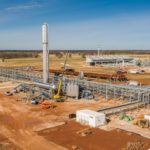Petroquest Energy, Inc. (NYSE: PQ) reported Q4’11 and year-end results, provided guidance for 2012, and announced an amendment to its Woodford Shale joint development agreement (JDA) to include an expansion into PetroQuest’s Mississippian Lime play.
PQ reported Q4’11 net income of $2.8 million, or $0.04 per share, compared to net income of $2.1 million, or $0.03 per share during Q4’10. Oil and gas revenues for Q4’11 totaled $38.0 million, compared to $43.4 million during Q4’10. Production during Q4’11 averaged 87 MMcfe/d compared to 86.3 MMcfe/d during Q4’10.
For the full-year 2011, PQ reported net income of $5.4 million, or $0.08 per share, compared to $42.0 million during the full-year 2010. The average net income per share estimate for fiscal year 2011 was $0.07 from the four analysts that cover the company. Oil and gas revenues for 2011 totaled $160.5 million compared to $179 million during for 2010. Production during the full-year 2011 averaged 82.7 MMcfe/d compared to 84.8 MMcfe/d during the full-year 2010.
OAG360 Comments:
Production Numbers Down but Within Stated Guidance; Grows Reserves to Record Levels:
Although PQ’s total 2011 production volumes were approximately 2.6% lower than its total 2010 production volumes, PQ’s 2011 daily production of 82.7 MMcfe/d was well within PQ production guidance of between 80 MMcfe/d to 88 MMcfe/d. OAG360 notes that PQ’s Q4’11 production was 87 MMcfe/d falling on the high side of expectations. During 2011, PQ grew its proved reserves 37% YOY to 265 Bcfe (61% proved developed) and reported its PV-10 is approximately $341.3 million. PQ’s 2011 proved reserves are the highest the company has ever reported. The company’s total proved reserves are estimated to comprise 91% natural gas, 3% oil and 6% NGLs. OAG360 notes that PQ exceeded its forecasted proved reserves growth rate of 25%.
PQ JVs the Mississippi Lime:
OAG360 views the expansion of PQ’s current Joint Venture with its drilling partner as the main headliner in the company’s news release. In addition to the Woodford Shale drilling portion, PQ will now be carried in the Mississippi Lime; however, the total drilling carry is unchanged at $92.7 million. The real question now is how the joint venture partnership will allocate capital between the Woodford and Mississippi Lime. Through the JV, PetroQuest currently owns 31,000 net acres in Pawnee, Grant and Kay Counties in Northern Oklahoma and Sumner County in Southern Kansas. The terms of the JV’s carry ratio were also adjusted so that PQ will pay 25% of drilling costs (from 20% previously), while still earning a 50% working interest. This agreement not only increases PQ’s short-term liquidity, but it will allow it to accelerate development of the Mississippian if its initial drilling program is successful, while still funding its CAPEX budget within cash flow.
In its year-end conference call, PQ guided for its initial Mississippian well costs to average $3.5 million per well. OAG360 estimates the JV extension will earn PQ $11.8 million in liquidity from the Mississippian during 2012. If the company drills 13.5 wells in the Mississippian (mid-point of guidance) at a gross cost of $47.25 million, the company’s allocation to the Mississippian will be approximately $11.8 million under the JV, where the company will pay 25% of well costs while earning a 50% working interest. If the JV had not been extended into the Mississippian, PQ would pay 50% of well costs or $23.6 million and earn a 50% working interest.
PQ’s Operating Costs Trend Lower:
Since 2008, PQ has decreased its trailing twelve months (TTM) operating (OPEX) and general and administrative (G&A) expenses 13% to $2.05 per Mcfe from $2.37 per Mcfe. The company achieved this by reducing its TTM OPEX and G&A expenses 27% and 12%, respectively, over the three year time period. As of September 30, 2011, PQ’s TTM OPEX and G&A expenses were $2.11 per Mcfe, below ECI’s 21 company micro-cap peer group average of $3.66 per Mcfe.
OAG 360 also notes that PetroQuest’s F&D costs have been trending lower since 2007, clearly demonstrating some measure of the company’s success in its transition to long-life onshore resource plays over the past few years. In 2007, the company reported $5.82/Mcfe F&D and subsequently drove its reported F&D to $1.64/Mcfe in 2011. This is a dramatic demonstration which validates the success PetroQuest has had in terms of developing its onshore assets over the past few years.
$95 Million 2012 CAPEX Guidance:
Using PQ’s midpoint guidance, the company plans to drill approximately 70 gross wells in 2012 with a CAPEX budget of $95 million. PQ plans to allocate 25% and 10% of its budget to the liquids rich Western Arkoma Basin (see graph below) where it plans to drill 20 gross wells and its oily Mississippian Lime where it plans to drill 12 to 15 gross wells. To fund its CAPEX budget, the company will use a combination of $125 million undrawn from its revolver, cash flow from operations and $22 million in cash-on-hand. PQ’s JV extension into the Mississippian provides a further source of liquidity, as its JV partner will carry the company on $92.6 million of drill costs in both its Mississippian and Woodford acreage. PQ is also considering selected divestitures of its acreage in both the Niobrara and Fayetteville which would provide an additional source of liquidity.








